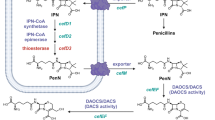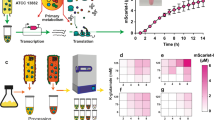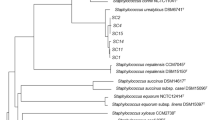Abstract
A high cephalosporin C producing strain of Cephalosporium acremonium produces higher levels of two enzymes of the bio–synthetic pathway than does a low–producing strain. More importantly, the deacetoxycephalosporin C synthetase of the superior strain appears to be deregulated with respect to carbon source repression. Thus screening or selecting for repression–resistant mutants would appear to be a useful general strategy for obtaining improved antibiotic producers.
This is a preview of subscription content, access via your institution
Access options
Subscribe to this journal
Receive 12 print issues and online access
$259.00 per year
only $21.58 per issue
Buy this article
- Purchase on SpringerLink
- Instant access to full article PDF
Prices may be subject to local taxes which are calculated during checkout
Similar content being viewed by others
References
Demain, A.L. 1983. Biosynthesis of β-lactam antibiotics, p. 189–228. In: Antibiotics Containing the β-lactani Structure. Demain, A. L. and Solomon, N. A. (eds.), Springer-Verlag, Heidelberg.
Wolfe, S., Demain, A.L., Jensen, S.E., and Westlake, D.W.S. 1984. Enzymatic approach to synthesis of unnatural beta-lactams. Science 226:1386–1392.
Shen, Y.-Q., Wolfe, S., and Demain, A.L. 1984. Desacetoxycephalosporin C synthetase: importance of order of cofactor/reactant addition. Enzyme Microb. Technol. 6:402–404.
Heim, J., Shen, Y.-Q., Wolfe, S., and Demain, A.L. 1984. Regulation of isopenicillin N synthetase and deacetoxycephalosporin C synthetase by carbon source during the fermentation of Cephalosporium acremonium. Appl. Microbiol. Biotechnol. 19:232–236.
Shen, Y.-Q., Heim, J., Solomon, N.A., Wolfe, S., and Demain, A.L. 1984. Repression of β-lactam production in Cephalosporium acremonium by nitrogen sources. J. Antibiot. 37:503–511.
Demain, A.L. 1983. Strain exchange between industry and academia. ASM News 49:431.
Hollander, I.J., Shen, Y.-Q., Heim, J., Demain, A.L., and Wolfe, S. 1984. A pure enzyme catalyzing penicillin biosynthesis. Science 224:610–612.
Drew, S.W. and Demain, A.L. 1975. The obligatory role of methionine in the conversion of sulfate to cephalosporin C. Eur. J. Appl. Microbiol. 1:121–128.
Park, J.T. and Johnson, M.J. 1949. A submicrodetermination of glucose. J. Biol. Chem. 181:149–151.
Bradford, M.M. 1976. A rapid and sensitive method for the quantification of microgram quantities of protein using the principle of protein dye binding. Analyt. Biochem. 12:248–254.
Kupka, J., Shen, Y.-Q., Wolfe, S., and Demain, A.L. 1983. Studies on the ring-cyclization and ring-expansion enzymes of β-lactam biosynthesis in Cephalosporium acremonium. Can. J. Microbiol. 29:488–496.
Author information
Authors and Affiliations
Rights and permissions
About this article
Cite this article
Shen, YQ., Wolfe, S. & Demain, A. Levels of Isopenicillin N Synthetase and Deacetoxycephalosporin C Synthetase in Cephalosporium acremonium Producing High and Low Levels of Cephalosporin C. Nat Biotechnol 4, 61–64 (1986). https://doi.org/10.1038/nbt0186-61
Received:
Accepted:
Issue date:
DOI: https://doi.org/10.1038/nbt0186-61
This article is cited by
-
Transcriptome analysis of the two unrelated fungal β-lactam producers Acremonium chrysogenum and Penicillium chrysogenum: Velvet-regulated genes are major targets during conventional strain improvement programs
BMC Genomics (2017)
-
Expression of cefF significantly decreased deacetoxycephalosporin C formation during cephalosporin C production in Acremonium chrysogenum
Journal of Industrial Microbiology and Biotechnology (2012)
-
Expression of cefD2 and the conversion of isopenicillin N into penicillin N by the two-component epimerase system are rate-limiting steps in cephalosporin biosynthesis
Molecular Genetics and Genomics (2004)



